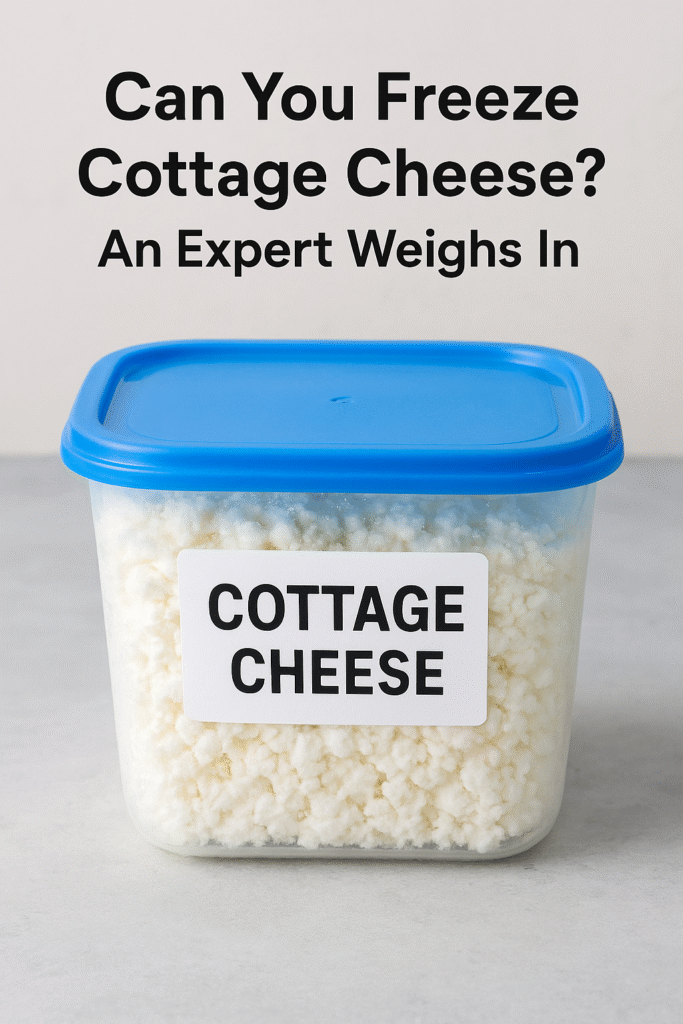🧀 Introduction
Have you ever wondered if we can freeze cottage cheese, especially after stocking up at the store? You may find you have an excess on hand, and the last thing you want to do is throw out any leftovers. Once you open a container, it only lasts about seven to ten days—roughly a week, depending on the brand you use. With such a short shelf life before it goes bad, you might wonder what to do. So, we asked Fred Tiess, a master instructor from Johnson & Wales University’s College of Food Innovation and Technology, to share his expert insight.
The good news, he tells Southern Living, is yes; you can freeze cottage cheese, but there are important points to know. Because of its high moisture content, ice crystals form during freezing, leading to water separation when defrosted. After thawing, the texture becomes icy and grainy. Tiess explains that using full-fat cottage cheese limits these changes, as higher fat content helps retain creaminess and flavor. With proper care, freezing is possible—making this high-protein, calcium-rich ingredient versatile for various dishes.
🧂 What Is Cottage Cheese?
Cottage cheese consists of distinct curds mixed with cream. It is classified as a fresh cheese, much like ricotta, baker’s cheese, paneer, or queso fresco. As Tiess explains, it’s made when an acid is added to milk, separating the solid curds from the liquid whey—a preservation method used for thousands of years. The curd is then cut, mixed with cream, and refrigerated to prevent mold or bacteria growth.
❄️ Is Freezing Cottage Cheese a Good Idea?
Yes, it’s perfectly safe to freeze cottage cheese, but expect texture changes. Its high moisture content forms ice crystals, giving a grainier consistency once thawed. If you enjoy it fresh, buy it as needed.
However, frozen cottage cheese works great in cooked dishes like lasagna, pancakes, and baked goods. The full-fat variety freezes better and maintains creaminess, while fat-free versions should be avoided since they don’t hold up well after thawing.
🧊 The Right Way to Freeze Cottage Cheese
There’s a right and wrong way to freeze cottage cheese, depending on how you plan to use it.
- Unopened container: Leave it sealed and wrap in plastic or place it inside a freezer-safe bag.
- Opened cottage cheese: Divide into small portions using airtight containers or freezer bags.
- Always label the date before freezing. It lasts 3–6 months, though one month is ideal for best quality.
- Avoid freezing old cottage cheese that’s been sitting too long in the fridge.
🧴 Dealing With an Extra Tub
If you bought two tubs and only used one, simply freeze the unopened one. Keep it in its original container, wrap with foil or plastic, seal in a freezer-safe bag, and label with the purchase date. This helps track its freshness and prevents waste.
🧁 Freezing Opened Cottage Cheese
For leftover cottage cheese:
- Transfer to freezer-safe containers or bags.
- Portion it for specific recipes.
- Wrap containers with foil or plastic for extra protection.
- Add a label with the date for easy tracking.
This ensures the cottage cheese remains safe and usable for future cooking.

🥣 How to Thaw Cottage Cheese
Thaw frozen cottage cheese slowly in the refrigerator for 18–24 hours. Avoid thawing on countertops as dairy spoils above 40°F. Once defrosted, a layer of liquid on top is normal—stir it in or drain for thicker consistency.
Tip: Add a spoonful of sour cream to improve creaminess. Never refreeze thawed cottage cheese, and always check for any sour smell before using.
🍳 How to Use Defrosted Cottage Cheese
Use thawed cottage cheese within two days. Its texture changes after freezing, so it’s best used in cooked dishes like pancakes, casseroles, or muffins rather than uncooked dips or desserts. Cooking helps restore smoothness and flavor.
🧭 Cottage Cheese Longevity
How Long Cottage Cheese Lasts in the Freezer
Cottage cheese can last 3–6 months in the freezer, though quality declines over time. Freezer burn and container damage are common issues. For best results, use within 1–2 months. After six months, flavor and texture often deteriorate beyond repair.
🍨 Leftover Cottage Cheese Recipes
How to Use Leftover Cottage Cheese
Even if frozen cottage cheese becomes grainy, you can still make delicious recipes. Tiess suggests using it in blended dishes—like pancakes, cheesecake, bread, kolache, or kugel.
👉 Pro Tip: Puree thawed cottage cheese in a food processor before baking to make it smooth and creamy.
Or, try Tiess’s banana berry cheesecake popsicles:
- 1 cup cottage cheese
- 1 ripe banana
- 1 cup frozen blueberries
- 1 tablespoon honey
Blend and freeze for a healthy, high-protein dessert — a perfect way to use leftover cottage cheese without waste.